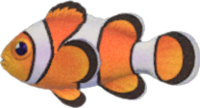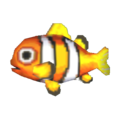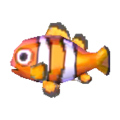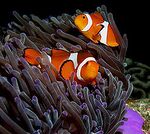Clown fish
| ||||||||
 | ||||||||
| Real-world info | ||||||||
|---|---|---|---|---|---|---|---|---|
| Name: Amphiprion ocellaris (ocellaris clownfish) Family: Pomacentridae (damselfishes) | ||||||||
| Main appearances | ||||||||
|
| ||||||||
| Other appearances | ||||||||
Names in other languages
クマノミ
小丑鱼 Poisson-clown Pez payaso Pesce pagliaccio Рыба-клоун
흰동가리 小丑魚 Poisson-clown Pez payaso Anemonenfisch Clownvis | ||||||||
The clown fish (formatted as the clownfish prior to New Leaf) is a fish in the Animal Crossing series introduced in Animal Crossing: Wild World. It appears as a tiny shadow in the sea all day from mid spring to early fall.
There is a variant in Animal Crossing: Pocket Camp called the black clown fish that appears during a Fishing Tourney.
Catch details[edit]
In Wild World[edit]
In City Folk[edit]
In New Leaf[edit]
| Time of year | Apr – Sep All year (Tortimer Island) |
|---|---|
| Time of day | All day |
| Peak times | May – Aug 15 |
| Location | Sea Tortimer Island |
| Shadow size | Tiny |
| Fish size | 15 cm |
| Selling price | |
| Furniture size |
In Pocket Camp[edit]
| Availability | Not currently available
|
|---|---|
| Location | |
| Shadow size | Tiny |
| Size | 12.5 cm – 17.5 cm |
| Rarity | ★★★ |
| Selling price | |
| Version added | Unknown |
| Villager gift data | Tier: 3 (Uncommon+)
Rewards:
|
In New Horizons[edit]
| Time of year | North: Apr – Sep South: Oct – Mar |
|---|---|
| Time of day | All day |
| Location | Sea |
| Shadow size | Tiny |
| Rarity | Common |
| Spawn requirement | Appears from the start of the game |
| Selling prices | |
| Furniture size |
Donating to the museum[edit]
Blathers will say the following once the fish has been donated to the museum:
In Wild World[edit]
It can be found in the sea tank at the back of the aquarium, swimming in the area around the anemones on the left side of the exhibit.
In City Folk[edit]
It can be found in the small tank on the right hand side of the aquarium, sharing its tank with the sea butterfly and surgeonfish.
In New Leaf[edit]
In New Horizons[edit]
When donating to Blathers or selecting "Tell me about this!" in New Horizons, he will provide the following information about the fish:
Fishing Tourney[edit]
During a Fishing Tourney, when given a clown fish, Chip will say the following dialogue.
In City Folk[edit]
In New Leaf[edit]
Gallery[edit]
Real-world information[edit]
Clownfish are native to Indian and Pacific water and can be found in the Great Barrier Reef and the Red Sea. They are usually paired with Surgeonfish and Butterflyfish when sharing tropical and reef aquariums. The species of clownfish featured in the Animal Crossing series is the common clownfish (Amphiprion ocellaris) which is the most recognizable clownfish and the one most likely found in commercial aquariums. They are usually peaceful, but have been known to attack each other. As mentioned by Blathers in City Folk, it holds a strong bond with sea anemones, using them as a home and place of shelter. Although sea anemones are toxic, they fail to poison clownfishes, because they have a mucus lining on their skin that protects them. The clownfish and the sea anemone feed each other respectively, with the clownfish feeding on undigested matter left by the sea anemone and the sea anemone eats what the clownfish excretes. Wild clownfish are very rarely caught to be used in private and public aquariums; they are now tank-bred, which insures they are more immune to diseases and less stressed when introduced to aquariums.
Names in other languages[edit]
| クマノミ kumanomi |
Clownfish. Lit. "kumadori fish" ("kumadori" is a type of makeup worn in kabuki) | |
| 흰동가리 huindonggari |
Clownfish | |
| 小丑鱼 xiǎochǒuyú |
Clownfish | |
| 小丑魚 Unknown |
||
| Рыба-клоун Ryba-kloun |
Clownfish | |
| Clownvis | Clownfish | |
| Anemonenfisch | Clownfish (lit. "Anemone fish") | |
| Pez payaso | Clown fish | |
| Poisson-clown | Clownfish | |
| Pesce pagliaccio | Clownfish | |
| Fish | |||||||||||||||||||||
|---|---|---|---|---|---|---|---|---|---|---|---|---|---|---|---|---|---|---|---|---|---|
| |||||||||||||||||||||
| Pocket Camp fish | ||||||||||||||||
|---|---|---|---|---|---|---|---|---|---|---|---|---|---|---|---|---|
| ||||||||||||||||








